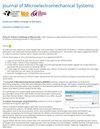Piezoresistive Angle Feedback Sensors With Various Schemes in MEMS Micromirrors
IF 3.1
3区 工程技术
Q2 ENGINEERING, ELECTRICAL & ELECTRONIC
引用次数: 0
Abstract
In recent years, the rapid development of Micro-Electro-Mechanical System (MEMS) technology has facilitated the widespread application of MEMS micromirrors in various precision instruments owing to their exceptional optical control capabilities. Meanwhile, the demand for increased accuracy in micromirror control has also grown steadily. This paper evaluates three distinct piezoresistive schemes for angle feedback in MEMS micromirrors, aiming to elucidate their key advantages and limitations while providing guidance for high-accuracy scheme selection. The comparison is based on the piezoresistive behavior of single-crystal silicon under identical n-type doping conditions. The angle feedback sensor is integrated into a custom-designed 1D MEMS electromagnetic micromirror, which features a multi-layer stacked assembly and a moving-magnet driving scheme. The peak-to-peak voltage (Vpp) in the feedback signal is comprehensively analyzed, and the rarely explored DC offset drift is also explicitly discussed. Experimental results reveal that the Wheatstone scheme provides the highest angle feedback sensitivity, measured at 6.96 mV/(VMEMS微镜中不同方案的压阻角反馈传感器
近年来,随着微机电系统(MEMS)技术的飞速发展,MEMS微镜以其优异的光学控制能力在各种精密仪器中得到了广泛的应用。同时,对微镜控制精度的要求也在稳步增长。本文评估了MEMS微镜中三种不同的压阻式角度反馈方案,旨在阐明它们的主要优点和局限性,同时为高精度方案的选择提供指导。比较是基于在相同n型掺杂条件下单晶硅的压阻行为。角度反馈传感器集成到定制设计的1D MEMS电磁微镜中,该微镜具有多层堆叠组件和移动磁铁驱动方案。全面分析了反馈信号中的峰值电压(Vpp),并明确讨论了很少被研究的直流偏置漂移。实验结果表明,Wheatstone方案提供了最高的角度反馈灵敏度,测量值为6.96 mV/(V $\cdot $ deg),而四端方案表现出最稳定的直流偏置漂移,在整个测试周期内最大仅为0.137 mV。(2024 - 0211)
本文章由计算机程序翻译,如有差异,请以英文原文为准。
求助全文
约1分钟内获得全文
求助全文
来源期刊

Journal of Microelectromechanical Systems
工程技术-工程:电子与电气
CiteScore
6.20
自引率
7.40%
发文量
115
审稿时长
7.5 months
期刊介绍:
The topics of interest include, but are not limited to: devices ranging in size from microns to millimeters, IC-compatible fabrication techniques, other fabrication techniques, measurement of micro phenomena, theoretical results, new materials and designs, micro actuators, micro robots, micro batteries, bearings, wear, reliability, electrical interconnections, micro telemanipulation, and standards appropriate to MEMS. Application examples and application oriented devices in fluidics, optics, bio-medical engineering, etc., are also of central interest.
 求助内容:
求助内容: 应助结果提醒方式:
应助结果提醒方式:


